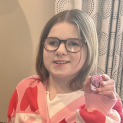Circulating Tumor Biomarkers: New Paradigms for Management of Neuroblastoma

Less than half of children with high-risk neuroblastoma are cured with current treatment. There is no way to predict response before giving this highly toxic treatment. Thus, there is a need for new ways to guide treatment choices. We aim to create a robust test using routine blood samples to follow disease and predict which patients will respond to standard treatment. Our team created a new method to find cancer DNA in blood samples. Using this method, we studied blood from children with neuroblastoma. Our test found small amounts of neuroblastoma DNA in their blood that was not found with standard tests. This test can be used to find patients who are resistant to standard therapy and may benefit from changes in treatment. We also found this test can separate patients with good response to treatment from those at high risk of their cancer coming back. To bring this to the clinic, we are testing samples from hundreds of patients enrolled on the largest active high-risk neuroblastoma clinical trial in North America. To date, we have sequenced approximately 1000 samples with more ongoing. We will confirm if our blood test is better than current clinical tests to detect otherwise unseen disease. We have also developed new was to track evidence of different kinds of neuroblastoma cells using the same blood samples. We have begun to assess how the amount of resistant neuroblastoma cells change with treatment. This project will lead to novel blood tests that will provide vital information for optimizing treatments for each patient to improve outcomes. We expect this will allow more children to receive just the right amount of treatment with fewer side effects.
Project Goals:
Every family facing a diagnosis of cancer wants to know treatment is working. Currently, the only way to answer this is with serial imaging and bone marrow biopsies. Drawbacks of these studies include the need for sedation, invasive biopsies, and radiation exposure, which can have short- and long-term side effects. Problematically, the information gained from these tests is far from perfect as many patients in clinical remission will relapse. The success of our proposal could lead to a true paradigm shift for selecting therapy and monitoring response for children with neuroblastoma. Because blood tests are simple and non-invasive, they can be done frequently and without side effects. The molecular information from this test is much richer than a simple image which can only tell whether there is a large mass or not. We envision that our test will allow us to move away from a one-size-fits-all approach to treating neuroblastoma. In the short- and medium-term, we expect to be able to rapidly identify children who are not responding to conventional chemotherapy and may benefit from novel approaches. Additionally, because we expect our test to be much more accurate that standard monitoring approaches, we expect to be able to identify patients who are truly in remission with greater reliability. In the long-term, we believe our test has the potential to replace much of the imaging and invasive biopsies currently being performed during and after treatment, saving patients from the risks of those tests while providing more accurate and useful information.
2025 Update:
To date, we have sequenced approximately 1900 samples with more ongoing. Although response data from the associated clinical trial is not yet available for analysis, we are optimistic about the ability of our method to detect the amount of circulating neuroblastoma DNA throughout treatment based on our preliminary analysis. We are actively assessing how the amount of resistant neuroblastoma cells change with treatment. Additionally, we have been working to identify and validate immune cell signatures which may reflect the composition of circulating immune cells. We plan to assess if these immune profiles can provide insights for improving the efficacy of immunotherapy approaches.

